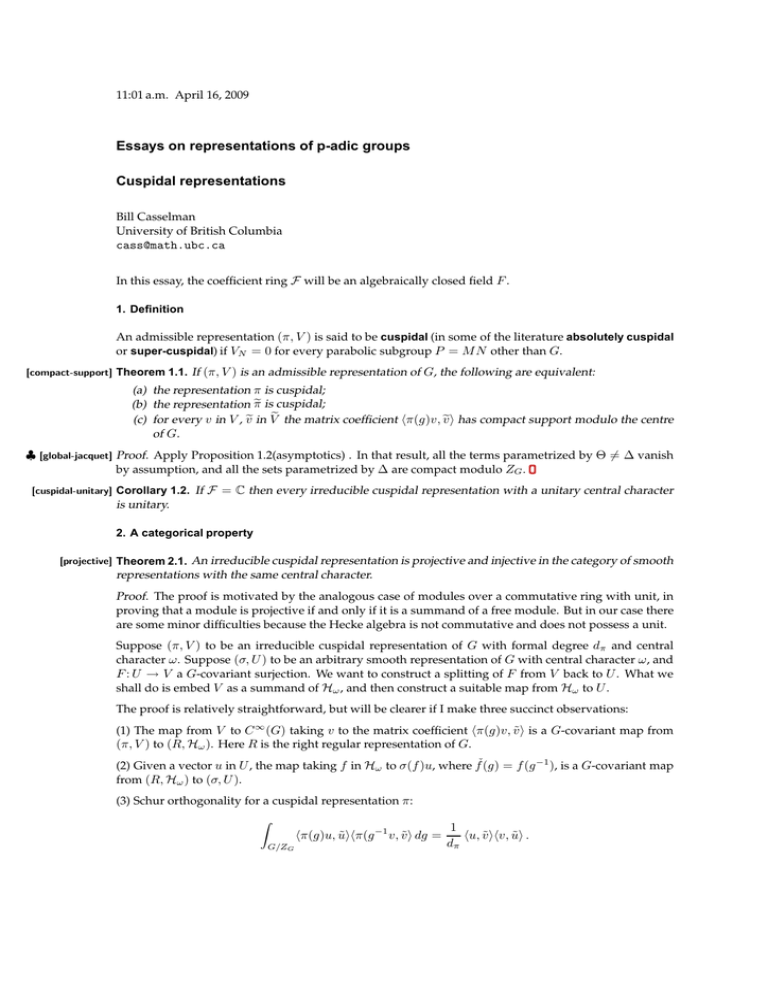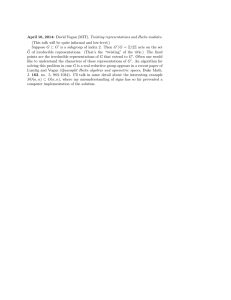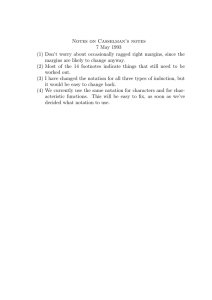Essays on representations of p-adic groups Cuspidal representations
advertisement

11:01 a.m. April 16, 2009 Essays on representations of p-adic groups Cuspidal representations Bill Casselman University of British Columbia cass@math.ubc.ca In this essay, the coefficient ring F will be an algebraically closed field F . 1. Definition An admissible representation (π, V ) is said to be cuspidal (in some of the literature absolutely cuspidal or super-cuspidal) if VN = 0 for every parabolic subgroup P = M N other than G. [compact-support] Theorem 1.1. If (π, V ) is an admissible representation of G, the following are equivalent: (a) the representation π is cuspidal; e is cuspidal; (b) the representation π (c) for every v in V , ve in Ve the matrix coefficient hπ(g)v, vei has compact support modulo the centre of G. ♣ [global-jacquet] Proof. Apply Proposition 1.2(asymptotics) . In that result, all the terms parametrized by Θ 6= ∆ vanish by assumption, and all the sets parametrized by ∆ are compact modulo ZG . [cuspidal-unitary] Corollary 1.2. If F = C then every irreducible cuspidal representation with a unitary central character is unitary. 2. A categorical property An irreducible cuspidal representation is projective and injective in the category of smooth representations with the same central character. [projective] Theorem 2.1. Proof. The proof is motivated by the analogous case of modules over a commutative ring with unit, in proving that a module is projective if and only if it is a summand of a free module. But in our case there are some minor difficulties because the Hecke algebra is not commutative and does not possess a unit. Suppose (π, V ) to be an irreducible cuspidal representation of G with formal degree dπ and central character ω . Suppose (σ, U ) to be an arbitrary smooth representation of G with central character ω , and F : U → V a G-covariant surjection. We want to construct a splitting of F from V back to U . What we shall do is embed V as a summand of Hω , and then construct a suitable map from Hω to U . The proof is relatively straightforward, but will be clearer if I make three succinct observations: (1) The map from V to C ∞ (G) taking v to the matrix coefficient hπ(g)v, ṽi is a G-covariant map from (π, V ) to (R, Hω ). Here R is the right regular representation of G. (2) Given a vector u in U , the map taking f in Hω to σ(f )u, where fˇ(g) = f (g −1 ), is a G-covariant map from (R, Hω ) to (σ, U ). (3) Schur orthogonality for a cuspidal representation π : Z G/ZG hπ(g)u, ũihπ(g −1 v, ṽi dg = 1 hu, ṽihv, ũi . dπ Cuspidal representations (11:01 a.m. April 16, 2009) 2 Now for the proof. Step 1. Fix ṽ0 in Ve and v0 in V such that hṽ, vi = dπ . For any v in V let γv be the matrix coefficient ♣ [compact-support] hπ(g)v, ṽ0 i. By Theorem 1.1 the map v 7→ γv embeds V into Hω (G). Step 2. We next want to define a G-covariant projection P from Hω → V . To do this, I shall pick a suitable vector v0 6= 0 in V and map f in Hω to Pf = Rfˇv0 . It follows from the remark (2) above that this is a G-covariant map from Hω to V . We now want to choose v0 so that Pγv = v for v in V . Well, we compute Pγv = Rγ̌v v0 Z γ̌v (x)π(x)v0 dx = G/Z Z = hπ(x−1 )v, ṽ0 iπ(x)v0 dx . G/Z This last is an element of V . But according to Schur orthogonality DZ −1 hπ(x E )v, ṽ0 iπ(x)v0 dx, ṽ = G/Z Z hπ(x−1 )v, ṽ0 ihπ(x)v0 , ṽi dx = G/Z 1 hv, ṽihv0 , ṽ0 i . dπ so if we choose hπ(x)v0 , ṽ0 i = dπ then Pv = v . Step 3. Go back to our projection F : U → V . Choose u0 ∈ U with F (u0 ) = v0 . Let Π be the map from Hω to U taking f to σ(fˆ)u0 . Here fˆ(g) = f (g −1 ). This is a G-morphism. The diagram Hω−1 P Π U F V is commutative, so F ◦Π = P, and Π◦γ splits F . F ◦(Π◦γ) = (F ◦Π)◦γ = P ◦γ = I







![Symmetry-protected topological orders of one- dimensional spin systems with D[subscript 2]+T symmetry](http://s2.studylib.net/store/data/012070116_1-f32a7fd07c57867227c547a02a0b6740-300x300.png)